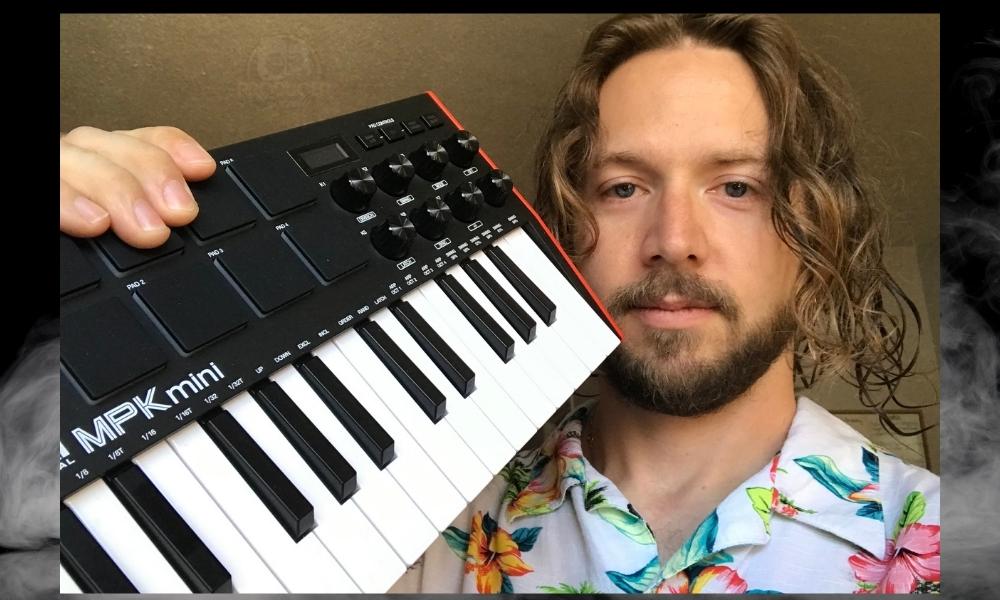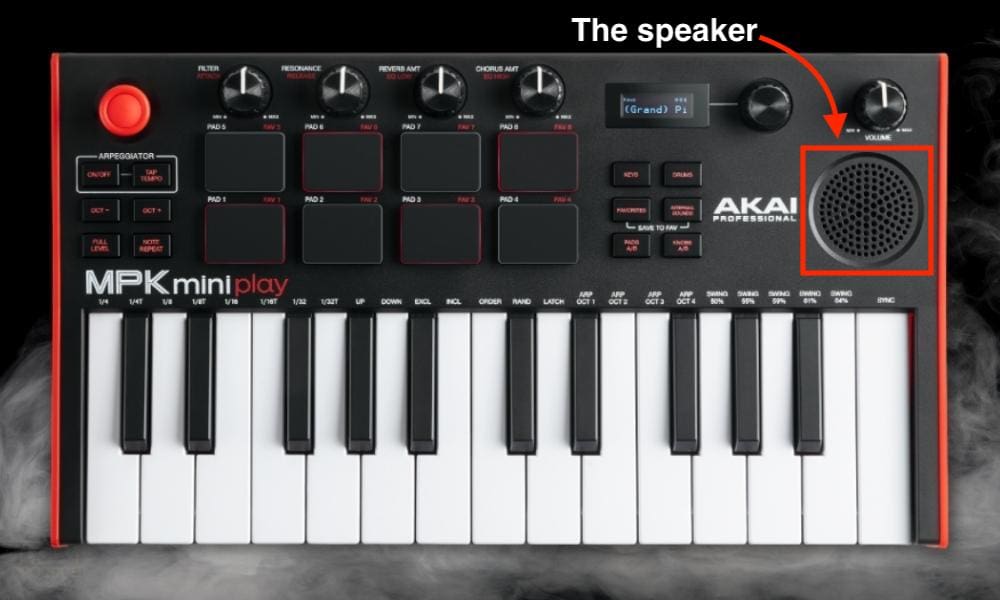AKAI has made it so you can use their classic controller without your computer.
To use the AKAI Mini MPK 25 without a computer, you have to either use a DAW loaded onto a smartphone or tablet, or use the AKAI Mini MPK Play instead. The Play edition of the classic Akai MIDI keyboard can function as a stand-alone music-making device due to the built-in speaker and MIDI sounds.
2 Ways of Using an AKAI MPK Mini Without A Computer

In my guide on how to use a MIDI keyboard as a piano without a DAW, I briefly explained how a MIDI keyboard like the AKAI MPK Mini MK3 can’t be used without some other kind of external device.
It acts as a MIDI controller, and not as an electric piano, which often has its own speakers and ability to play sound. That said, apparently, AKAI realized there was a market for people who would like to use the controller as a stand-alone system because they came out with the AKAI MPK Mini 25 Play which does serve this purpose.
1) Use the AKAI MPK Mini PLAY Instead of the AKAI MPK Mini

in simple terms, the AKAI MPK Mini Play comes with a bunch of stock sounds that you can use to play wherever you’re at. Moreover, you have the ability to adjust the filter, reverb, chorus, resonance, and volume, in addition to the attack and release. So ultimately you get some control over how it sounds.
For many people, this will be a great device to use for all kinds of things including live looping, or even something as simple as jamming over a backing track with your guitar.
Personally, I don’t find the sounds on the AKAI MPK Mini to be that bad, especially considering its usual functions as a MIDI keyboard, in addition to the fact that it doesn’t even cost that much. Neither does the Akai MPK Mini, for that matter.
TAETRO did a review on his YouTube channel where he talked about how he didn’t like the sounds of it too much but ultimately came around on the device after many in his fanbase noted how much they liked the keyboard and for all kinds of purposes. So what does the Akai MPK Mini Play have that the regular MPK Mini doesn’t?
Features of the Akai MPK Mini Play
- Built-in Speaker (Acts as a stand-alone device)
- 128 Stock Sounds
- 4 Dials for Controlling the Sound (Filter, Resonance, Reverb, Chorus)
- Battery-Powered with 3 AA Batteries
- Headphone Jack
- Ability to connect to external speakers
- Comes with MPC Beats
Ultimately, I’m a big fan of the concept, however, I haven’t reached out and grabbed my own MPK Mini Play because I’m still getting plenty of use out of my regular Akai MPK Mini. As I think about it, I kind of regret not getting the Akai Mini Play instead, because for just $10 extra, acting as a stand-alone device is a great addition.
Important Tip :
Make sure you get the new model of the Akai MPK Mini Play MKIII because there is an MPK Mini Play that’s based on the first generation MPK Mini.
You don’t want that one, because, as I said in my article on the subject, the latest Akai MPK Mini (MKIII) is built much better, has actual MPC drum pads, a better key-bed, endless encoder knobs, and is just a much better device overall. It’s far less “toy-like” than the previous models tended to be.
2) Use an iPad, iPhone, or Another Mobile Device
![iPad, iPhone, MacBook Pro - How to Use the AKAI MPK Mini Without A Computer [Guide]](https://producersociety.com/wp-content/uploads/2022/07/iPad-iPhone-MacBook-Pro-How-to-Use-the-AKAI-MPK-Mini-Without-A-Computer-Guide.jpg)
You may or may not already know this, but most MIDI keyboards can also be used on a mobile device, assuming that you don’t need to install drivers and also assuming that you have a mobile DAW installed. iPads, iPhones, and other tablets and smartphones are very capable of making music as well.
I’m currently using the iPhone X 64GB as well as the iPad Pro 11″ 1TB as my mobile devices with GarageBand installed on both of them. For the mobile phone, you need the USB Camera/Multiport Adapter to USB adapter to connect the MPK Mini, and for the iPad, you need a USB-C to USB adapter to connect a MIDI keyboard.
![The Adapters for the iPhone/iPad - How to Use the AKAI MPK Mini Without A Computer [Guide]](https://producersociety.com/wp-content/uploads/2022/07/The-Adapters-for-the-iPhoneiPad-How-to-Use-the-AKAI-MPK-Mini-Without-A-Computer-Guide.jpg)
On the right: USB-C to USB adapter (also on Amazon)
Due to the size of the iPhone and iPad, it’s really not hard for me to have a music-making studio. The iPad and Magic Keyboard easily fit into my bag, as does the AKAI MPK Mini if I want to bring it with me.
So, in simple terms, if you don’t want to use a standard laptop or desktop computer, no worries, because you can also use a smartphone or a tablet device as long as you have the necessary adapter. Here’s how you connect the Akai MPK Mini to your phone and tablet.
How to Connect Your Akai MPK Mini to a Smartphone (iPhone)
![AKAI MPK Mini to iPhone - How to Use the AKAI MPK Mini Without A Computer [Guide]](https://producersociety.com/wp-content/uploads/2022/07/AKAI-MPK-Mini-to-iPhone-How-to-Use-the-AKAI-MPK-Mini-Without-A-Computer-Guide.jpg)
To connect an AKAI MPK Mini 25 to your smartphone, all you really need is the USB/Camera Multiport Adapter, as they’re called on Amazon, and a DAW installed on your mobile device. On an iPhone, GarageBand iOS works great, but if you’re using Android you could probably use FL Studio instead.
One thing that I found weird about this set-up, however, is that for whatever reason, I can only connect the AKAI MPK Mini to the iPhone with the Multiport Adapter, and not my regular Thunderbolt to USB adapter, despite the fact they both serve the same function.
Initially, I thought maybe the iPhone didn’t have enough power to drive the AKAI MPK Mini, but it turns out that it does on its own, without the use of a power bank which I showed you how to use in my guide on how to set up a Scarlett 2i2 with an iPad/iPhone.
When I try to use the regular Thunderbolt to USB adapter to make the connection, I wind up getting the following message:
![Cannot Use MPK Mini 3 - How to Use the AKAI MPK Mini Without A Computer [Guide]](https://producersociety.com/wp-content/uploads/2022/07/Cannot-Use-MPK-Mini-3-How-to-Use-the-AKAI-MPK-Mini-Without-A-Computer-Guide.jpg)
How to Connect Your Akai MPK Mini to a Tablet (iPad)
![iPad to AKAI MPK Mini - How to Use the AKAI MPK Mini Without A Computer [Guide]](https://producersociety.com/wp-content/uploads/2022/07/iPad-to-AKAI-MPK-Mini-How-to-Use-the-AKAI-MPK-Mini-Without-A-Computer-Guide.jpg)
The same principle should apply to other kinds of smartphones, tablets, and mobile devices. Most of them use a similar port. You could argue that this is still “using a computer,” because smartphones and tablets have computers in them, but that’s an issue of semantics.
If you’re trying to use the AKAI MPK Mini without a laptop or a standard PC or computer, just know that you can often connect it to your phone or tablet, and that’s kind of the point of this article. But if you’re really trying to use the MPK Mini without any external device at all, you’d be better off using the MPK Mini Play instead.
Important Things to Note About Using An AKAI MPK Mini Without A Computer
1) Connectivity May Also Depend On The Age of Your Device
I know, for example, that my iPhone 7 Plus struggles to power external devices like the Scarlett 2i2 and the AKAI MPK Mini on their own, and for that reason, you have to use the camera/multiport adapter to connect a power bank.
The power bank provides the necessary power for everything to run properly. The article I referenced earlier on connecting the Scarlett 2i2 to iPhones/iPads will help you out with that.
Gear Mentioned
1) AKAI MPK Mini 25 MKIII
2) AKAI MPK Mini Play MKIII
3) USB Camera/Multiport Adapter
4) USB-C to USB adapter


 Written By :
Written By : 
Thanks for ur idea of using the MPK mini play.
Am frm Nigeria..I love singing but have zero idea about how to produce matching sound to my songs, though am preparing to buy an mpk..but can i record my song to the phone and get the right quality sound?
Thanks sir.
No problem. The MPK Mini Play is a standard MIDI keyboard just like the MPK Mini, but it has some basic sounds in it and a built-in speaker. It’s pretty cool for jamming and messing around, but don’t expect the sounds that come from it to be amazing like they would be with a high quality electric piano.